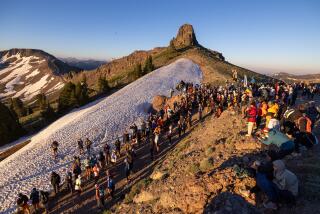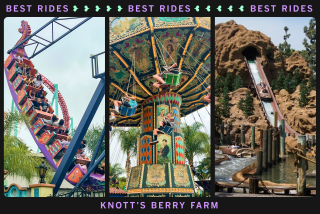Cyclists Ride the Range--Though It Feels More Like a Stove
- Share via
WICHITA FALLS, Tex. — When Texas towns throw summer festivals to scare up tourist dollars, the party tends to go a little rough on the animals.
In Sweetwater they trap rattlesnakes, in Anahuac they hunt alligators and at the World Championship Barbecue Goat Cookoff and Arts and Crafts Fair in Brady . . . well, you get the idea.
On the Saturday before Labor Day weekend, though, the animals get even.
That’s when Wichita Falls puts on the Hotter ‘N Hell Hundred, a bicycle ride across 100 miles of North Texas ranch and oil land in temperatures near or above 100 degrees.
At this shindig, it’s the people who roast on the spit.
The Hotter ‘N Hell Hundred goes hard on these humans--or rather, these humans go hard on themselves.
As the sun starts glowing and the Great Plains winds notch up to blow dryer force, the route, it has been said, begins to resemble the road to Saigon.
At the rest stops--tents at 10-mile intervals--groups of up to a thousand overheated peddlers litter the ground like so much road kill, gathering the strength, fluids and resolve to press on.
Not infrequently, flatbed trucks and vans and ambulances flash by, hauling in the vanquished.
The scene gets progressively uglier past the 50-mile mark, gleefully dubbed Hell’s Gate I. The head of the ride’s complement of about 400 medical professionals calls the terra beyond the gate the “high risk” zone--and the M.A.S.H.-style medical tents are usually rocking.
At the 1989 HHH, as it is called, 11,875 recreational riders steamed out from the 7:30 a.m. start. By the end of the day, 682 required medical attention--just over half of those for heat cramps, heat exhausting and other temperature-related problems.
But that was a good year.
In 1988, when ride-day temperature actually reached 100 and the winds blew hard, doctors and nurses hooked 276 people to saline-solution IVs. Worse yet, the HHH registered its first fatality. A 51-year-old Kansan with a history of heart trouble keeled over with a coronary attack after reportedly ignoring warnings to stop and climb off.
The ride’s name notwithstanding, organizers, civic boosters and well-trained cyclists tend to play down the self-inflicted pain and suffering quotient that gives the HHH its fame.
At the Wichita Falls visitor’s bureau, assistant manager Lisa Bodin talks about how “families with little ones” turn out to tackle the shorter distances--the 10-, 25-, 50- and 62-mile courses.
In its coverage of the 1989 event, the Wichita Falls Times and Record News played up the lack of serious injuries--only 34 were hospitalized, nobody died--and the holiday atmosphere brought on by the big crowd.
The newspaper, which prints a 56-page section for the event and mails it to participants, was also quick to tout how the out-of-towners booked nearly every motel room in a 50-mile radius and spent almost $1 million on food, lodging, cycle stuff and on and on.
There is that side of it.
But the image that adheres more in people’s minds when they talk about the HHH is the scene at the finish as the August sun, Wichita Falls’ lemon for the lemonade, starts barbecuing the plodders.
It’s a picture of a less-than-perfectly-trained 100-miler wobbling in after six or eight or 10 hours in the saddle. Looking like a truck with a bad radiator, the two-wheel zombie lurches across the line, drops from his or her bike and begins vomiting at the edge of the road.
Just over a year ago, James Goodwin, Joe Vacek and Stanley Wren were three professional guys on garden-variety bicycles out for weekend spins in Houston parks.
Nothing heavy. Just a little workout for the waistline. A little nudge to the cardiovascular system.
“We’d joke about the ‘cycle geeks,’ ” says Goodwin of the stern-faced enthusiasts who’d pump by in bright Lycra shorts and funny helmets on their way to who knows where.
But something a little nutty crept into their lives as the year went by.
More than 10 million cycles were sold in 1989 as the national cycling boom continued to surge. Goodwin, Vacek and Wren bought three of them--and helmets, poison-green shorts, special handlebar rigs, “hydration systems,” pedal systems, cycling shoes. . . .
High-carbohydrate drink mixes, energy boosters and protein potions began multiplying in their kitchens. Their freezers sprouted crops of portable water bottles, chilling for the next training run, the next long ride.
This summer, the three entered the Katy Flatland 100, their first “century,” and they finished in about six and a half hours counting stops. Next on their list is the Hotter ‘N Hell Hundred.
Eighty percent of the 1989 riders were between 21 and 50, and 71% were men. About half of them shot for 100 miles, the rolling answer to a marathon. “You go out on a ride and you see underneath it there’s this terrifically masochistic pulse,” says Lawrence Wright, an Austin, Tex., free-lance writer who has survived the race.
“You’re out there and you think there’s this leather-suited lady with a whip bestriding you. It’s a narcosis, like being a hundred feet underwater and the current is pulling you. You’re enraptured by it.”
At the HHH, the best-attended 100-mile ride in the nation, the attraction is heightened because you feel you’re being pulled by the crowd, he says.
For Wichita Falls, a recession-struck oil city of 95,000 that has been losing population over the decade, the HHH has become enormous in terms of money, image and publicity.
Just about everything surrounding the race, from police assistance to the hauling of 90,000 pounds of ice to the rest stops, is volunteered or provided free for promotional purposes, says Jo-Alice Davis, the ride committee’s business manager.
The well-stocked rest areas, some pitched with themes such as “Christmas in August” or “Tropical Paradise,” are manned by local businesses. To make up for the shortage of area motel and hotel rooms, about 300 residents lend their homes to the cause, offering bed and breakfast for nominal $10- or $20-a-night fees.
“Most people think this is put on by the Board of Commerce and Industry,” says race founder Roby Christie, referring to the city’s economic development agency. “It isn’t. It actually started out as a little local event to go along with our centennial.”
As the story goes, Wichita Falls’ centennial committee hired an expert to plan the summer of 1982. The consultant came back with the idea of holding a rocking chair contest.
“We didn’t think that captured the spirit that built this area,” says Christie, a post office customer service manager who at the time had just formed a cycle club.
“Century” rides were rare in the early ‘80s, but the idea fit.
In an unintentional stroke of marketing genius, a member of Christie’s cycling club offered the name--an obvious choice for Wichita Falls in late August.
The first year, about 1,100 locals hit the road, including a few kids on drop-on-the-driveway, fat-tired banana bikes who finished the 100-mile loop.
Soon enough, though, the growing cycle crowd found its way to Wichita Falls and the ride with the toothsome name. Every year through 1988, total entries grew by a number equal to the total of the two previous years.
What started as a one-day event grew to four--all the better to keep the visitors in town.
Some of the city’s more rigid Christians remain put off by the ride’s name and it alienates a handful of potential sponsors, says Christie. “They don’t want to be affiliated with hell.”
Underneath it all, there’s a bigger issue, too--the problem of putting so much stake in an event that is tough enough, under the worst of conditions, to kill.
The paradox of keeping the ride safe but challenging enough to keep drawing hard-riding enthusiasts has weighed heavily on the HHH, particularly since 1988, the year it was hotter ‘n’ hell and 92 people were packed off to hospital emergency rooms.
That year, even avid cyclists such as David Danford, president of the San Antonio Wheelmen and a 100-mile-a-week, mid-summer trainer, found the going rough. “The wind was terrible,” he recalls.
As the ride’s medical director, Dr. Jerry Alexander’s job has been to think long and hard about safety at the HHH, and it isn’t easy.
In 1989, Alexander decided in the middle of the ride to cut the course short for at least 2,000 “century” riders who had failed to reach the 60-mile mark in less than three hours and 45 minutes.
He made the decision, he says, because forecasters predicted the wind would pick up through the afternoon.
It didn’t, and the call prompted grumbling around Wichita Falls and a folder full of angry cyclists’ letters.
Still, several new precautions were added this year. Among them: An extra rest stop was set up about 75 miles into the ride, on the western leg of the route.
“People come to this ride with personal goals. They don’t quit on them easily,” Alexander says, explaining how many riders will usually put up an argument before admitting their dreams of finishing are torn.
“We’re the bad guys, I know,” he says. “But somebody out there has to be realistic. Somebody has to say they’ve had enough.”
Editor’s note: 11,560 recreational cyclists started th e August, 1990 , ride . That day the mercury hit 103, and, just above street level, reportedly was measured at 119. Alas, no figures are kept on how many starters actually finish the race.
Reprinted by permission of the Fort Worth Star-Telegram.
More to Read
Sign up for The Wild
We’ll help you find the best places to hike, bike and run, as well as the perfect silent spots for meditation and yoga.
You may occasionally receive promotional content from the Los Angeles Times.






